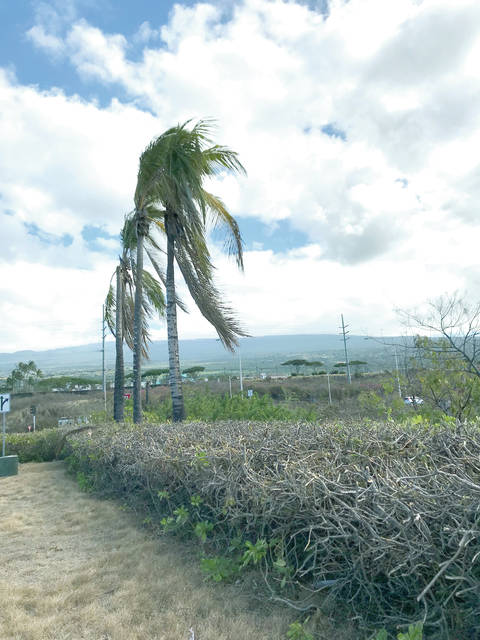February and March are notorious for blustery weather, but this year it combines with extra-dry weather, especially in Kona.
A drive around Kailua-Kona is depressing if you take note of the stores and streets where water has been turned off during this dry spell. Check our Makalapua Street as an example. Most of the median strip plantings are dead, and even older landscapes with dead palms, oleander and naupaka give witness that irrigation was terminated.
This means tens of thousands of dollars worth of trees and shrubs have been destroyed by lack of care.
What a waste!
When it comes to wind damage, now is a good time to think about pruning.
February has already been windy and the forecast for much of March is the same.
Winter storms are like unwanted company since they often come when they are least expected. One year we have none, the next we have several. It is important to be prepared.
Before the storm flag is hoisted, inspect your trees for dead branches that seem to be ready to fall. Also look for dead branches that are firm but brittle. A gust of wind can snap an arm-sized branch from a tree and send it at missile speed.
A low hanging branch over a roof can wreak havoc. Powerful winds can turn the limb into a tool of destruction. This tool can remove shingles as easily as a fish can remove scales. Removing dead and out-of-place limbs is a good idea even if there is no storm.
Fan-like fungus growing on the side of a tree trunk indicates rotten spots that need attention. A hole made by poor pruning, damage from earlier storms or the gouge of an auto bumper can start rotten spots. Remove decayed trees that are too weak to hold up under the strain of a storm. This action will save you grief later.
Palm fronds are wicked to deal with if propelled by wind. So clean away all loose palm leaves at the first hint of a storm. Be careful not to overprune the palms. Overpruning will weaken and could even kill them.
With global warming, weather extremes are possible. This week it might be dry and windy. Next week we could have flooding!
If your home is located in an area that might be flooded, you will hopefully be given ample notice to evacuate hours before the storm reaches your area. Otherwise, there is no safer place than in a well-built home. So far this winter those cold fronts from Alaska have not brought rain, but some folks on Kauai and Oahu have still not fully recovered from last year’s storms.
As soon as the storm passes it is a good idea to inspect the trees and other plants around the house. Usually, all the plants will show signs of wind damage. But with a little trimming, propping, resettling of root systems and fertilizing and watering, nearly all plants that were shaken loose from the ground can be salvaged.
Many of our tropical trees grow rampant with extensive root systems. That is why we prune to keep them from getting out of hand, but let’s prune the right way. Now is a good time to prune. Spring and summer are not the best time for excessive pruning since shade is at a premium during those hot days ahead.
As crazy as the weather might be this winter, remember the old saying “March arrives like a lion but it leaves like a lamb.”
The most important thing to consider when it comes to taking care of our Hawaii gardens is to be aware of the needs of the trees shrubs and grasses that make our islands beautiful. Don’t neglect your garden needs any more than you would neglect your pet cat or dog.
Plants have feelings too!
For tips on garden care, call the Master Gardeners at the University of Hawaii College of Tropical Agriculture and Human Resources in the Kona and Hilo offices. The numbers are 322-4893 and 981-5199, respectively.



